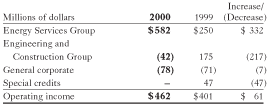|
 |
 |

Consolidated operating income was $462 million for 2000 compared to $401 million for 1999. Engineering and Construction segment results include restructuring charges of $36 million in 2000 related to the restructuring of the engineering and construction businesses. See Note 11. Excluding the restructuring charge in 2000 and the special credits of $47 million in 1999, operating income for 2000 increased by 41% from 1999.
operating income in 2000 was $582 million, an increase of 133% from 1999 operating income of $250 million. Operating margins were 8.6% in 2000, up from 4.2% in 1999. Operating income from our oilfield services product service lines was $452 million. During 2000, strengthening North American drilling and oilfield activity resulted in increased equipment utilization and improved pricing within the oilfield services product service lines. Pressure pumping operating income increased about 135% compared to 1999 levels, while logging services operating income increased by almost 170% compared to 1999. Drilling fluids, drilling systems and completion products were impacted by slow recovery in international activity. During the fourth quarter of 2000, oilfield services recorded an $8 million reversal of bad debts related to claims settled by the United Nations against Iraq dating from the invasion of Kuwait in 1990. Geographically, strong oil and gas prices throughout 2000 led to higher levels of deepwater and onshore gas drilling within North America. Activity increases in the Gulf of Mexico, South Texas, Canada, and Rocky Mountain work areas were greater than most other areas. Operating income outside North America continued to lag the performance noted within North America, reflecting continued delays in international exploration and production for oil and gas. However, fourth quarter 2000 operating income increased across all international geographic regions compared to the third quarter of 2000, reflecting increased international spending by our customers.
Operating income in 2000 for the remainder of the segment was $130 million. Operating income benefited in 2000 from a third quarter $88 million pretax gain on sale of two semi-submersible vessels and one multipurpose support vessel and increasing profitability in the integrated exploration and production information systems product service line. Excluding the gain of the sale of the vessels, operating income declined in the Surface/Subsea product service lines. Lower activity levels in the North Sea United Kingdom sector and under-utilization of manufacturing and subsea equipment and vessels, which carry large fixed costs, were the primary factors for the decline in operating income. Operating income from integrated exploration and production information systems in 2000 increased almost 200% compared to 1999, reflecting higher software and professional services revenues.
recorded an operating loss for 2000 of $42 million compared to operating income of $175 million in 1999, a decrease of 124%. The operating margin was 2.7% in 1999. Operating margins in 2000 declined both internationally and in North America due to losses on projects as a result of higher than estimated costs on selected jobs and claims negotiations on other jobs not progressing as anticipated. Given the number and technical complexity of the engineering and construction projects we perform, some project losses are normal occurrences. However, the environment for negotiations with customers on claims and change orders has become more difficult in the past few years. This environment, combined with performance issues on a few large, technically complex jobs, contributed to unusually high job losses on large projects of $171 million in 2000, including $167 million in the fourth quarter. At the same time, the group recorded $36 million of restructuring charges. Lower activity due to the trend in delayed new projects, which continued through 2000, also negatively impacted operating income. Operating income in 1999 benefited from higher activity levels supporting United States military peacekeeping efforts in the Balkans, offset by reduced engineering and construction project profits due to the timing of project awards and revenue recognition.
in 1999 are the result of a change in estimate on some components of the 1998 special charges. In the second quarter of 1999, we concluded that total costs, particularly for severance and facility exit costs, were lower than previously estimated. Therefore, we reversed $47 million of the $959 million special charge that was originally recorded.
for 2000 were $78 million, an increase of $7 million from 1999. In 2000 general corporate expenses increased primarily as a result of costs related to the early retirement of our previous chairman and chief executive officer.
|
|
|